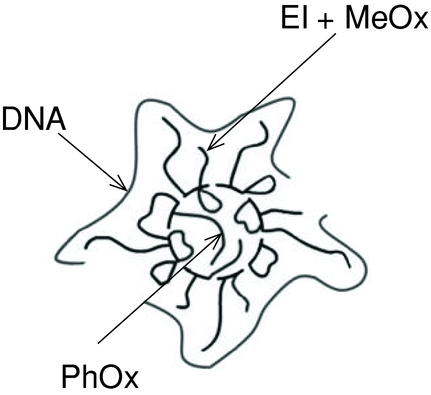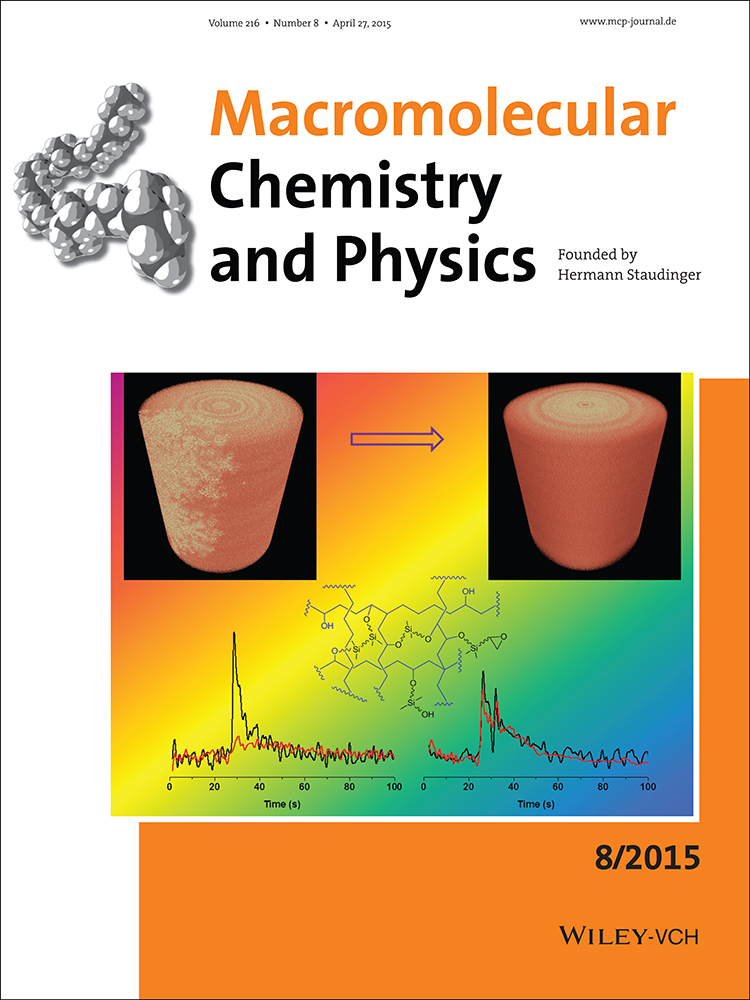Solution Behavior of Hydrolyzed Gradient Methyl/Phenyl Oxazoline Copolymers and Complexation with DNA
Eleni Vlassi
Theoretical and Physical Chemistry Institute, National Hellenic Research Foundation, 48 Vassileos Constantinou Avenue, 11635 Athens, Greece
Search for more papers by this authorCorresponding Author
Stergios Pispas
Theoretical and Physical Chemistry Institute, National Hellenic Research Foundation, 48 Vassileos Constantinou Avenue, 11635 Athens, Greece
E-mail: [email protected]Search for more papers by this authorEleni Vlassi
Theoretical and Physical Chemistry Institute, National Hellenic Research Foundation, 48 Vassileos Constantinou Avenue, 11635 Athens, Greece
Search for more papers by this authorCorresponding Author
Stergios Pispas
Theoretical and Physical Chemistry Institute, National Hellenic Research Foundation, 48 Vassileos Constantinou Avenue, 11635 Athens, Greece
E-mail: [email protected]Search for more papers by this authorAbstract
Partial hydrolysis of 2-methyl-2-oxazoline/2-phenyl-2-oxazoline gradient copolymers (MPOx copolymers) results in amphiphilic copolymers containing cationic ethylene imine, neutral hydrophilic 2-methyl-2-oxazoline, and hydrophobic 2-phenyl-2-oxazoline segments (HMPOx copolymers). The solution behavior of the HMPOx copolymers has been investigated in water, phosphate buffer saline (PBS), and fetal bovine serum (FBS) by static, dynamic, and electrophoretic light scattering and fluorescence spectroscopy. The copolymers form stable spherical aggregates in aqueous media with positive surface charge. The aggregates are found to interact extensively with proteins in FBS solutions. Soluble HMPOx/DNA complexes have also been formed in aqueous media at certain HMPOx/DNA compositions due to electrostatic interactions. The polyplexes have been studied in terms of structure and colloidal stability.
Supporting Information
As a service to our authors and readers, this journal provides supporting information supplied by the authors. Such materials are peer reviewed and may be re-organized for online delivery, but are not copy-edited or typeset. Technical support issues arising from supporting information (other than missing files) should be addressed to the authors.
| Filename | Description |
|---|---|
| macp201400552-sup-0001-S1.pdf273.7 KB | Supplementary |
Please note: The publisher is not responsible for the content or functionality of any supporting information supplied by the authors. Any queries (other than missing content) should be directed to the corresponding author for the article.
References
- 1G. Riess, Prog. Polym. Sci. 2003, 28, 1107.
- 2W. H. Binder, H. Gruber, Macromol. Chem. Phys. 2000, 201, 949.
- 3R. Hoogenboom, Angew. Chem. Inter. Ed. 2009, 48, 7978.
- 4Y. Zhang, A. Satterlee, L. Huang, Mol. Ther. 2012, 20, 1298.
- 5N. Adams, U. S. Schubert, Adv. Drug Delivery Rev. 2007, 59, 1504.
- 6D. A. Tomalia, D. P. Sheetz, J. Polym. Sci., Part A-1: Polym. Chem. 1966, 4, 2253.
- 7H. Eliyahu, Y. Barenholz, A. Domb, Molecules 2005, 10, 34.
- 8D. Wakebayashi, N. Nishiyama, K. Itaka, K. Miyata, Y. Yamasaki, A. Harada, H. Koyama, Y. Nagasaki, K. Kataoka, Biomacromolecules 2004, 5, 2128.
- 9R. Bahulekar, N. R. Ayyangar, S. Ponrathnam, Enzyme Microbiol. Technol. 1991, 13, 858.
- 10L. Cong, R. Kaul, U. Dissing, B. Mattiasson, J. Biotechnol. 1995, 42, 75.
- 11R. M. Cordes, W. B. Sims, C. E. Glatz, Biotechnol. Prog. 1990, 6, 283.
- 12J. Suh, H. J. Paik, B. K. Hwang, Bioorg. Chem. 1994, 22, 318.
- 13W. T. Godbey, K. K. Wu, A. G. Mikos, J. Controlled Release 1999, 60, 149.
- 14O. Boussif, F. Lezoualc'h, M. A. Zanta, M. D. Mergny, D. Scherman, B. Demeneix, J. P. Behr, Proc. Natl. Acad. Sci. 1995, 92, 7297.
- 15J. H. Jeong, S. H. Song, D. W. Lim, H. Lee, T. G. Park, J. Controlled Release 2001, 73, 391.
- 16J. C. Fernandes, X. Qiu, F. M. Winnik, M. Benderdour, X. Zhang, K. Dai, Q. Shi, Int. J. Nanomed. 2013, 8, 4091.
- 17J. W. Wiseman, C. A. Goddard, D. McLelland, W. H. Colledge, Gene Ther. 2003, 10, 1654.
- 18H. M. L. Lambermont-Thijs, M. J. H. C. Jochems, R. Hoogenboom, U. S. Schubert, J. Polym. Sci., Part A: Polym. Chem. 2009, 47, 6433.
- 19C. Englert, L. Tauhardt, M. Hartlieb, K. Kempe, M. Gottschaldt, U. S. Schubert, Biomacromolecules 2014, 15, 1124.
- 20H. P. C. van Kuringen, V. R. de la Rosa, M. W. M. Fijten, J. P. A. Heuts, R. Hoogenboom, Macromol. Rapid Commun. 2012, 33, 827.
- 21B. J. Berne, R. Pecora, Dynamic Light Scattering, Plenum Press, New York, 1976.
- 22B. Chu, Laser Light Scattering, Academic Press, New York, 1991,
- 23M. B. Huglin, Light Scattering from Polymer Solutions, Academic Press, New York, 1972.
- 24P. Kratochvil, Classical Light Scattering from Polymer Solutions, Elsevier, Amsterdam, 1987.
- 25M. Hrubý, Cˇ. Konˇák, K. Ulbrich, J. Controlled Release 2005, 103, 137.
- 26C. H. Chen, J. Wilson, W. Chen, R. M. Davis, J. S. Riffle, Polymer 1994, 35, 3587.
- 27S. A. Ekhorutomwen, S. P. Sawan, B. F. Smith, T. W. Thomas, K. V. Wilson, Solution Behavior of Modified Polyethylenimine (PEI) Polymers by Light Scattering Investigations, Technical Report DOE/ER/14764, Univ. of Massachusetts, Lowell, USA, 2004.
10.2172/822405 Google Scholar
- 28B. Trzebicka, N. Koseva, V. Mitova, A. Dworak, Polymer 2010, 51, 2486.
- 29V. Tandon, S. K. Bhagavatula, W. C. Nelson, B. J. Kirby, Electrophoresis 2008, 29, 1092.
- 30S. Honary, F. Zahir, Trop. J. Pharm. Res. 2013, 12, 255.
- 31H. M. L. Lambermont-Thijs, J. P. A. Heuts, S. Hoeppener, R. Hoogenboom, U. S. Schubert, Polym. Chem. 2011, 2, 313.
- 32X. Sun, S. Chen, J. Han, Z. Zhang, Int. J. Nanomed. 2012, 7, 2929.
- 33R. Tanaka, I. Ueoka, Y. Takaki, K. Kataoka, S. Saito, Macromolecules 1983, 16, 849.
- 34X. Zeng, Y. Sun, X. Zhang, S. Cheng, R. Zhuo, Pharm. Res. 2009, 26, 1931.
- 35Y. Milonaki, E. Kaditi, S. Pispas, C. Demetzos, J. Polym. Sci., Part A: Polym. Chem. 2012, 50, 1226.
- 36B. Stuart, Infrared Spectroscopy: Fundamentals and Applications, John Wiley and Sons, Chichester, UK 2004.
10.1002/0470011149 Google Scholar
- 37S. Choosakoonkriang, B. A. Lobo, G. S. Koe, J. G. Koe, C. R. Middaugh, J. Pharm. Sci. 2003, 92, 1710.
- 38T. Yang, A. Hussain, S. Bai, I. Khalil, H. Harashima, F. Ahsan, J. Controlled Release 2006, 115, 289.
- 39S. Gunasekaran, D. Uthra, Ind. J. Pure Appl. Phys. 2008, 46, 100.
- 40B. Hirzinger, M. Helmstedt, J. Stejskal, Polymer 2000, 41, 2883.
- 41S. M. Zou, E. Patrick, J. S. Remy, J. P. Behr, J. Gene Med. 2000, 2, 128.
10.1002/(SICI)1521-2254(200003/04)2:2<128::AID-JGM95>3.0.CO;2-W CAS PubMed Web of Science® Google Scholar
- 42J.-P. Clamme, G. Krishnamoorthy, Y. Mely, Biochim. et Biophys. Acta (BBA)–Biomembr. 2003, 1617, 52.
- 43R. Kircheis, L. Wightman, E. Wagner, Adv. Drug Delivery Rev. 2001, 53, 341.
- 44J. Zhu, A. Tang, L. P. Law, M. Feng, K. M. Ho, D. K. Lee, F. W. Harris, P. Li, Bioconjug. Chem. 2005, 16, 139.
- 45M. A. Winnik, S. M. Bystryak, J. Siddiqui, Macromolecules 1999, 32, 624.
- 46A. F. Thunemann, S. General, Macromolecules 2001, 34, 6978.
- 47B. Ochietti, N. Guerin, S. V. Vinogradov, Y. St. Pierre, P. Lemieux, A. V. Kabanov, V. Yu Alakhov, J. Drug Targeting 2002, 10, 113.
- 48X. Jiang, N. Petkov, S. K. Alexander, R. Azencott, B. G. Bodmann, A. Bouamrani, C. Chiappini, M. Ferrari, X. Liu, E. Tasciotti, in Computer Analysis of Images and Patterns, Springer, Berlin, Heidelberg, 2009, p. 590.
10.1007/978-3-642-03767-2 Google Scholar
- 49A. Siemiarczuk, W. Ware, Chem. Phys. Lett. 1990, 167, 263.
- 50A. von Harpe, H. Petersen, Y. Li, T. Kissel, J. Controlled Release 2000, 69, 309.
- 51M. da Graca Miguel, Adv. Colloid. Interface Sci. 2001, 89–90, 1.
- 52R. R. Sawant, S. K. Sriraman, G. Navarro, S. Biswas, R. A. Dalvi, V. P. Torchilin, Biomaterials 2012, 33, 3942.
- 53X. Huang, A.-V. Hartley, Y. Yin, J. H. Herskowitz, J. J. Lah, K. J. Ressler, J. Virol. Methods 2013, 193, 270.
- 54S. E. Reed, E. M. Staley, J. P. Mayginnes, D. J. Pintel, G. E. Tullis, J. Virol. Methods 2006, 138, 85.





